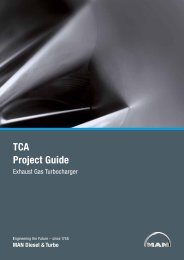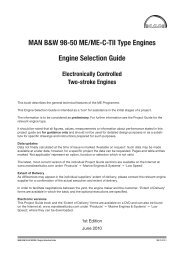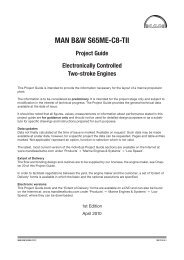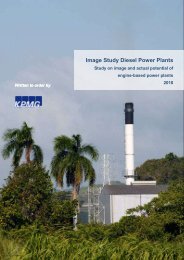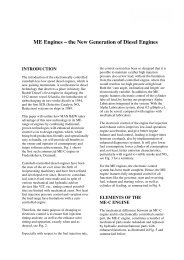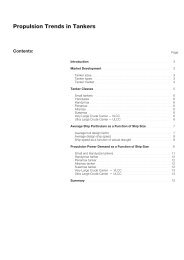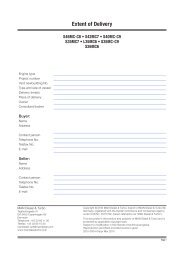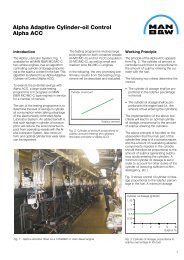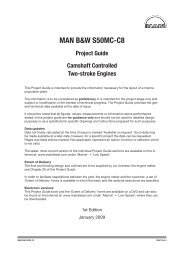This section is available on request - MAN Diesel & Turbo
This section is available on request - MAN Diesel & Turbo
This section is available on request - MAN Diesel & Turbo
You also want an ePaper? Increase the reach of your titles
YUMPU automatically turns print PDFs into web optimized ePapers that Google loves.
<strong>MAN</strong> B&W 3.02<br />
Exhaust Gas By�pass<br />
Extreme Ambient C<strong>on</strong>diti<strong>on</strong>s<br />
As menti<strong>on</strong>ed in Chapter 1, the engine power<br />
figures are valid for tropical c<strong>on</strong>diti<strong>on</strong>s at sea<br />
level: 45 °C air at 1000 mbar and 32 °C sea water,<br />
whereas the reference fuel c<strong>on</strong>sumpti<strong>on</strong> <str<strong>on</strong>g>is</str<strong>on</strong>g> given<br />
at ISO c<strong>on</strong>diti<strong>on</strong>s: 25 °C air at 1000 mbar and<br />
25 °C charge air coolant temperature.<br />
Marine diesel engines are, however, exposed to<br />
greatly varying climatic temperatures winter and<br />
summer in arctic as well as tropical areas. These<br />
variati<strong>on</strong>s cause changes of the scavenge air<br />
pressure, the maximum combusti<strong>on</strong> pressure, the<br />
exhaust gas amount and temperatures as well as<br />
the specific fuel oil c<strong>on</strong>sumpti<strong>on</strong>.<br />
For further informati<strong>on</strong> about the possible countermeasures,<br />
please refer to our publicati<strong>on</strong> titled:<br />
Influence of Ambient Temperature C<strong>on</strong>diti<strong>on</strong>s<br />
The publicati<strong>on</strong> <str<strong>on</strong>g>is</str<strong>on</strong>g> <str<strong>on</strong>g>available</str<strong>on</strong>g> at: www.mandiesel.com<br />
under ‘Quicklinks’ → ‘Technical Papers’<br />
Arctic running c<strong>on</strong>diti<strong>on</strong><br />
For air inlet temperatures below �10 °C the precauti<strong>on</strong>s<br />
to be taken depend very much <strong>on</strong> the<br />
operating profile of the vessel. The following alternative<br />
<str<strong>on</strong>g>is</str<strong>on</strong>g> <strong>on</strong>e of the possible countermeasures.<br />
The selecti<strong>on</strong> of countermeasures, however, must<br />
be evaluated in each individual case.<br />
<strong>MAN</strong> B&W S80MC, S80MC-C/ME-C, K80MC-C/ME-C, S70MC,<br />
S70MC-C/ME-C/ME-GI, L70MC-C/ME-C, S65ME-C/ME-GI,<br />
S60MC, S60MC-C/ME-C/ME-GI/ME-B, L60MC-C/ME-C,<br />
S50MC, S50MC-C/ME-C/ME-B, S46MC-C/ME-B, S42MC,<br />
S40MC-C/ME-B, S35MC, S35MC-C/ME-B, L35MC, S26MC6<br />
<strong>MAN</strong> <strong>Diesel</strong><br />
Page 1 of 2<br />
Exhaust gas receiver with variable by�pass<br />
Opti<strong>on</strong>: 4 60 118<br />
Compensati<strong>on</strong> for low ambient temperature can<br />
be obtained by using exhaust gas by�pass system.<br />
<str<strong>on</strong>g>Th<str<strong>on</strong>g>is</str<strong>on</strong>g></str<strong>on</strong>g> arrangement ensures that <strong>on</strong>ly part of the<br />
exhaust gas goes via the turbine of the turbocharger,<br />
thus supplying less energy to the compressor<br />
which, in turn, reduces the air supply to<br />
the engine.<br />
Please note that if an exhaust gas by�pass <str<strong>on</strong>g>is</str<strong>on</strong>g> applied<br />
the turbocharger size and specificati<strong>on</strong> has<br />
to be determined by other means than stated in<br />
th<str<strong>on</strong>g>is</str<strong>on</strong>g> Chapter.<br />
Emergency Running C<strong>on</strong>diti<strong>on</strong><br />
Exhaust gas receiver with total by�pass flange<br />
and blank counterflange<br />
Opti<strong>on</strong>: 4 60 119<br />
By�pass of the total amount of exhaust gas round<br />
the turbocharger <str<strong>on</strong>g>is</str<strong>on</strong>g> <strong>on</strong>ly used for emergency running<br />
in the event of turbocharger failure <strong>on</strong> engines,<br />
see Fig. 3.02.01.<br />
<str<strong>on</strong>g>Th<str<strong>on</strong>g>is</str<strong>on</strong>g></str<strong>on</strong>g> enables the engine to run at a higher load<br />
with <strong>on</strong>ly <strong>on</strong>e turbocharger under emergency<br />
c<strong>on</strong>diti<strong>on</strong>s. The engine’s exhaust gas receiver will<br />
in th<str<strong>on</strong>g>is</str<strong>on</strong>g> case be fitted with a by�pass flange of approximately<br />
the same diameter as the inlet pipe<br />
to the turbocharger. The emergency pipe <str<strong>on</strong>g>is</str<strong>on</strong>g> yard’s<br />
delivery.<br />
198 45 93�4.5



